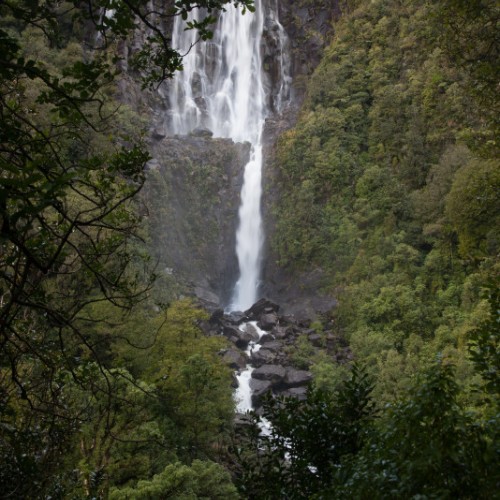Wairere Falls Track weaves its way through moss covered rocks and tree roots. Large round boulders form natural pools and cascading waterfalls.
A spectacular view of the falls can easily be seen from Old Te Aroha Road.
From the car park, a wellformed track leads through moss-covered rocks and tree roots.
It meets up with the river and crosses a number of bridges. There is a steady climb up the steps to the base of the cliff, through a grove of nīkau, pūriri and kohekohe, before leading to a lookout platform with a spectacular view of the falls (45 minutes from road end).
The falls drop 153 m over the steep escarpment, which is part of the Okauia fault line. In spring, watch out for the apricot-coloured flowers of the taurepo plant on the rocky valley walls.
The track then climbs further, with plenty of steps and staircases in the steeper section. At the top of the hill, the track passes through forest before reaching the falls lookout after about 90 minutes.
Return the same way.
Alternative route (tramping track)
From the top of the falls take the Wairere Track east to the North South Track. This section is not as well maintained as the climb to Wairere Falls.
Getting there
Wairere Falls Track is on Goodwin Road off Te Aroha-Okauia road, south of Te Aroha.
Nature and conservation
The Wairere Falls track takes walkers through a beautiful, diverse range of natural scenery. Besides the spectacular 153 m high falls there are beautiful river falls and cascades, a fine grove of nīkau, pūriri and kohekohe, and an upper section of track takes you through tree ferns and tōtara in native forest.
Know before you go
- You need to be well prepared when tramping on conservation land, especially on the longer day walks. Ensure you have strong, comfortable boots, warm clothing, a good raincoat, first aid kit, food and drink, a hat and sunscreen.
- Before you go into the outdoors, tell someone your plans and leave a date to raise the alarm if you haven't returned. To do this, use the New Zealand Outdoors Intentions process (external site) on the AdventureSmart website. It is endorsed by New Zealand's search and rescue agencies and provides three simple options to tell someone you trust the details about your trip.
- Consult a topographic map.
- Mountain biking is not permitted.
Source: Department of Conservation
Track Closed Until Further Notice
Track is closed due to dangerous rock fall and the potential for further land movement.







